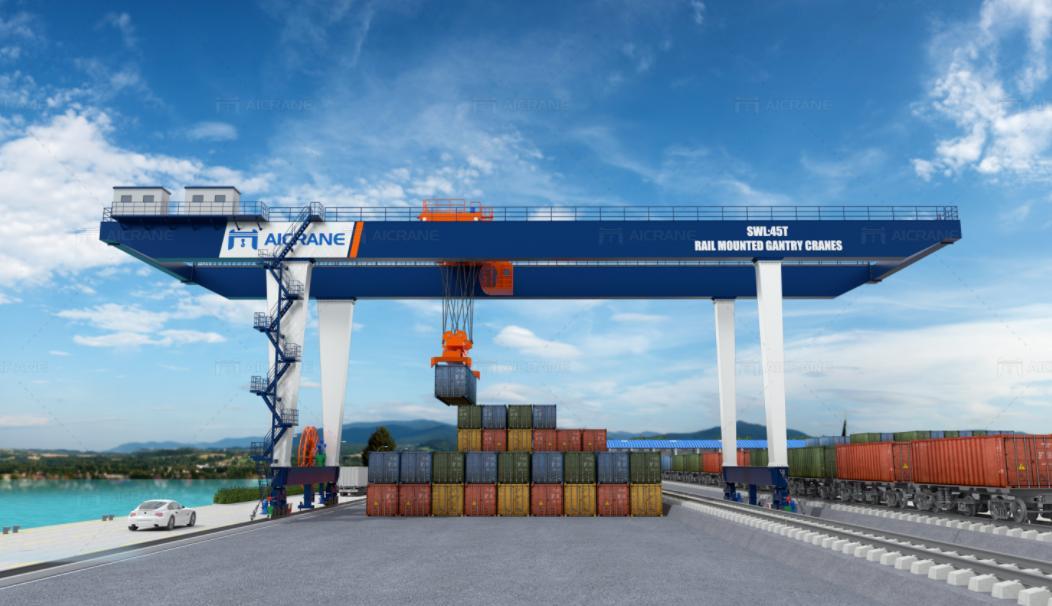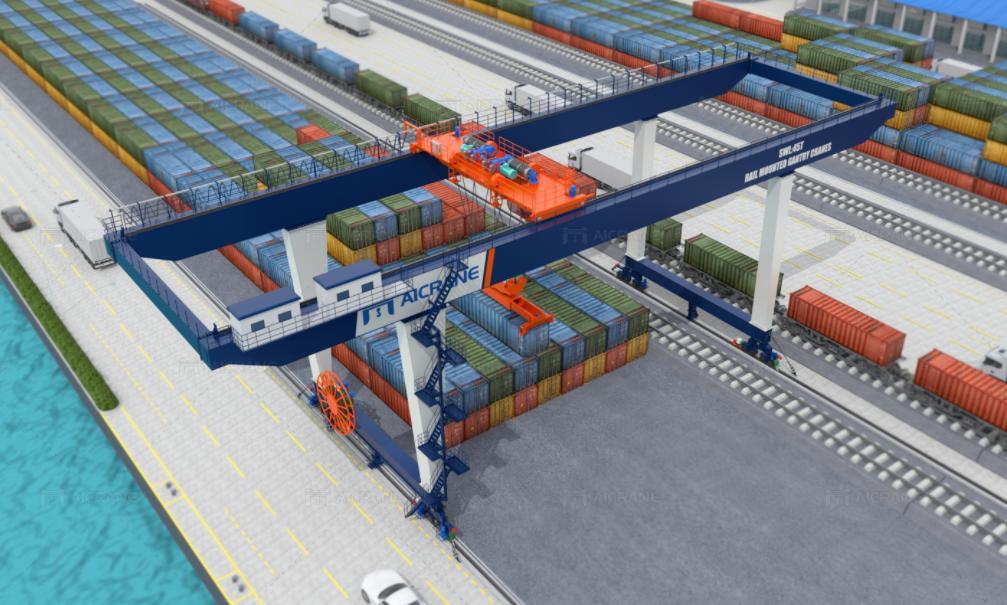In the world of modern logistics, container handling plays a crucial role in ensuring the smooth operation of ports, shipping yards, and container terminals. As container handling demands continue to grow in terms of volume and efficiency, the use of Rail-Mounted Gantry (RMG) cranes has become indispensable. These cranes are specialized for loading and unloading containers from trucks, trains, and ships. One of the standout features of RMG cranes is their ability to be tailored to meet the specific needs of a port or terminal, optimizing their performance and ensuring operational efficiency. This article explores the importance of tailored design in RMG cranes, discussing how custom features can enhance container handling operations and improve safety, productivity, and cost-effectiveness.

The Importance of RMG Cranes in Container Handling
RMG cranes are commonly found in container yards and ports, where they are responsible for stacking and retrieving containers from the ground or moving them to and from railcars and trucks. These cranes are mounted on rails, which provide a stable and controlled movement along the yard, allowing them to work with high precision. Their role is crucial, as they help manage large quantities of containers that need to be transported, stored, or loaded/unloaded with minimal delay.
Unlike traditional gantry cranes, which may be used for lifting other heavy loads in various industrial settings, rail mounted gantry cranes are specifically designed for container handling. They offer features such as adjustable spreaders, precise hoisting mechanisms, and advanced control systems to ensure containers are handled safely and efficiently. The demand for higher throughput, reduced operation costs, and minimal environmental impact is driving the development of tailored RMG cranes for specific applications.
The Benefits of Tailored Design
1. Optimized Performance for Specific Applications
One of the primary reasons for opting for a tailored design for RMG cranes is the ability to optimize the crane for specific operational needs. Container terminals face various operational challenges based on factors like layout, available space, and the types of vessels or cargo they handle. By designing RMG cranes that are tailored to the unique requirements of the terminal, businesses can ensure that their equipment will perform optimally.
For example, a terminal with limited space may require an RMG crane that offers a smaller footprint but can handle heavy-duty operations. Alternatively, a terminal handling oversized containers may need a crane with specialized lifting mechanisms and extended reach capabilities. Tailored design ensures that the crane is built with the right features to meet the particular demands of the facility.
2. Increased Throughput and Efficiency
Container handling operations can benefit greatly from custom-tailored RMG cranes, particularly in terms of improving throughput and reducing cycle times. By adjusting key design elements like the lifting height, span, and speed of the crane, manufacturers can create RMG cranes that are better suited to the specific operations of a terminal.
For example, a port that primarily handles small to medium-sized containers might require an RMG crane that is optimized for faster lifting speeds and quicker turnaround times. On the other hand, terminals handling larger containers may need a crane designed for greater lifting capacity and additional hoisting precision. Customizing the crane's specifications can help increase throughput and reduce the time needed for each container move, resulting in better overall efficiency.
3. Enhanced Safety Features
Safety is paramount in any crane operation, and this is especially true for container handling, where heavy lifting is involved. Tailored RMG cranes can be designed with additional safety features that address specific hazards in the terminal environment. These features might include improved anti-sway systems, load monitoring technologies, and enhanced braking systems.
Anti-sway technology, for example, helps minimize the swinging of containers during hoisting, preventing accidents and reducing the risk of damage to both the container and the crane. In addition, load monitoring systems ensure that containers are lifted within the crane's safe working load limits, protecting both the equipment and the workforce.
By tailoring the crane’s safety features to the unique conditions of the terminal, it is possible to mitigate risks and enhance operational safety.

4. Cost-Effectiveness and Energy Efficiency
Tailoring RMG cranes to meet the specific needs of a terminal can also have significant cost benefits. When cranes are designed with efficiency in mind, they can reduce energy consumption and minimize operating costs. For example, an RMG gantry crane for container handling designed to handle lighter loads at a faster pace may be built with energy-efficient motors and drive systems to reduce electricity usage, making the crane more cost-effective over time.
Moreover, customizing the crane's design allows businesses to avoid the expense of over-specifying equipment. A terminal that does not require the highest lifting capacity or the longest span can save money by opting for a more appropriately sized crane, reducing both upfront capital investment and maintenance costs.
5. Flexibility for Future Growth
Container terminals are dynamic environments that often experience fluctuations in demand, changes in cargo types, and the introduction of new technologies. One of the key advantages of designing RMG cranes with tailored features is the flexibility to adapt to future requirements.
For example, a crane can be equipped with modular components that allow for easy upgrades as operational needs change. This could include the addition of new hoisting systems, increased lifting capacity, or the ability to handle different types of containers as the terminal evolves. By planning for future growth, businesses can ensure that their RMG cranes continue to meet their needs for years to come.
Key Design Elements for Tailored RMG Cranes
Several key design elements should be considered when customizing an RMG crane for container handling:
1. Lifting Capacity
The lifting capacity is one of the most critical design factors for an RMG crane. It determines the weight of the containers the crane can lift, and ensuring that the crane has the correct capacity for the terminal's typical loads is essential. A crane with too high a capacity may be more expensive and inefficient, while one with insufficient capacity may struggle to handle larger containers, leading to operational delays.
2. Span and Lifting Height
The span of the crane determines how far it can reach across the yard, while the lifting height dictates how high it can raise containers. Tailoring these dimensions ensures that the crane can effectively cover the terminal’s layout and stack containers at the required height. The crane’s reach must be aligned with the container storage configuration to avoid unnecessary congestion and optimize yard space utilization.
3. Control Systems and Automation
Incorporating advanced control systems into RMG cranes is another key area for customization. Modern RMG cranes often come equipped with automated or semi-automated features that reduce human error and improve efficiency. These systems include GPS tracking, load measurement sensors, and remote operation capabilities. Automation can also streamline processes such as stacking containers, enhancing throughput and reducing labor costs.
4. Stability and Anti-Sway Systems
RMG cranes can experience instability when lifting containers, especially during high winds or with large loads. Tailoring the crane’s stability system to meet the unique environmental conditions of the terminal is essential. Anti-sway systems, along with advanced load monitoring and stability enhancements, can ensure smooth and safe container handling in challenging conditions.
5. Environmental Considerations
As environmental concerns become more pressing in industrial settings, many container terminals are opting for energy-efficient RMG cranes. Customization can include the selection of low-emission power sources, energy-saving motors, and eco-friendly materials in the crane’s design. Additionally, the use of electric-powered cranes instead of diesel-powered ones can significantly reduce a terminal’s carbon footprint and operating costs.
Conclusion
Tailoring the design of RMG cranes for container handling is a strategic approach that can greatly enhance the operational efficiency, safety, and cost-effectiveness of a terminal. By considering factors such as lifting capacity, span, hoisting mechanisms, control systems, and automation, businesses can create cranes that are optimized for their specific needs. The ability to customize key design elements ensures that RMG cranes can adapt to the changing demands of the container handling industry, providing long-term benefits for both port operators and clients. As container handling technology continues to evolve, the importance of tailored crane design will remain a critical factor in maintaining competitive advantage and operational excellence in the global logistics landscape.